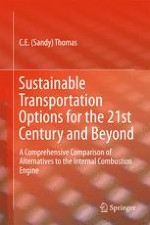2015 | OriginalPaper | Buchkapitel
3. Alternative Vehicle and Fuel Options
verfasst von : C. E. (Sandy) Thomas
Erschienen in: Sustainable Transportation Options for the 21st Century and Beyond
Aktivieren Sie unsere intelligente Suche, um passende Fachinhalte oder Patente zu finden.
Wählen Sie Textabschnitte aus um mit Künstlicher Intelligenz passenden Patente zu finden. powered by
Markieren Sie Textabschnitte, um KI-gestützt weitere passende Inhalte zu finden. powered by
